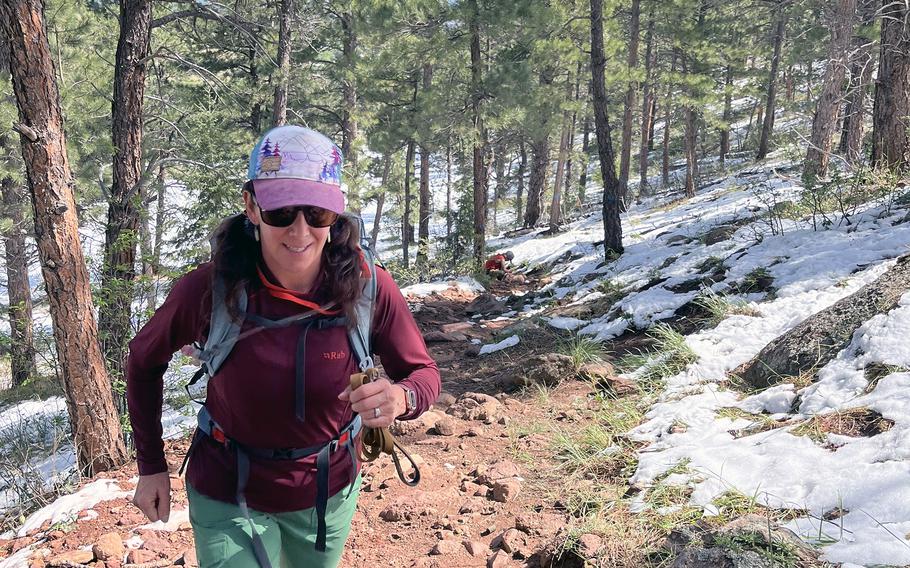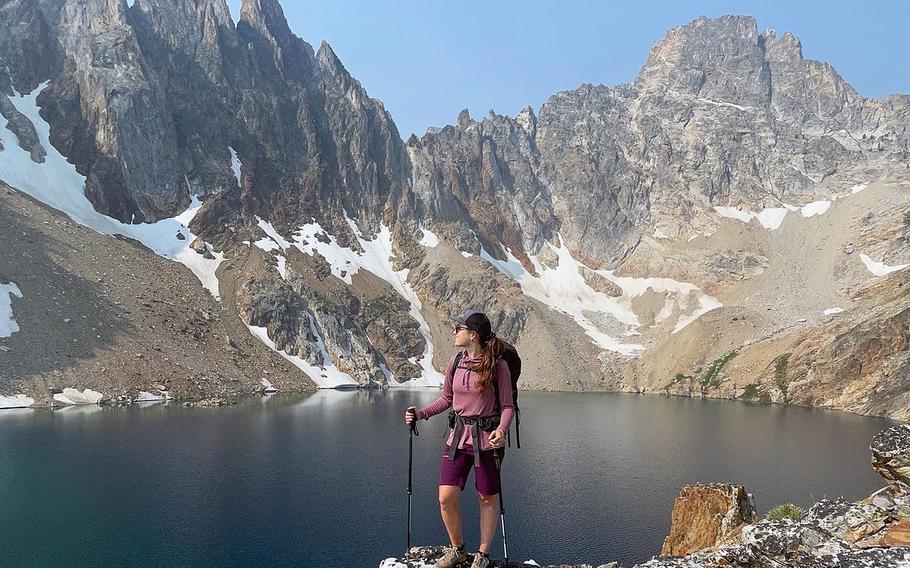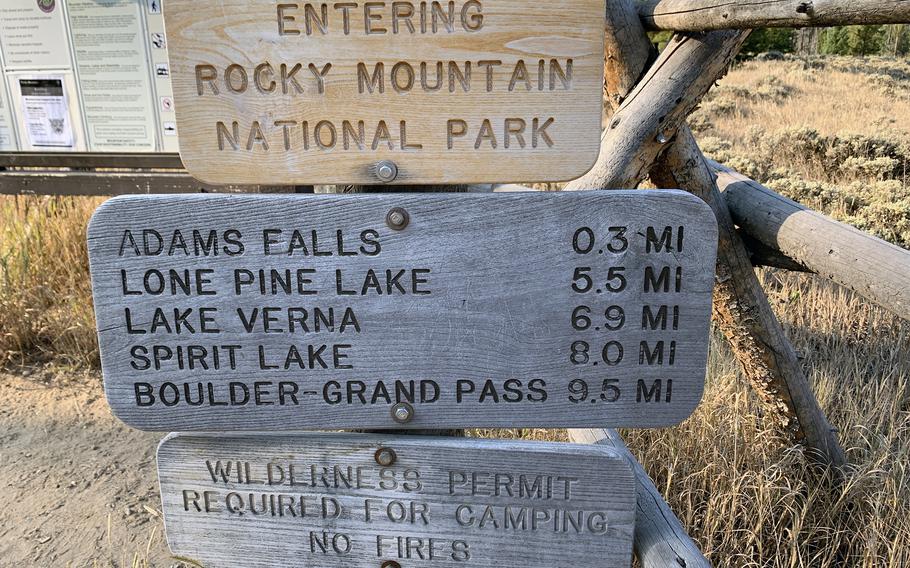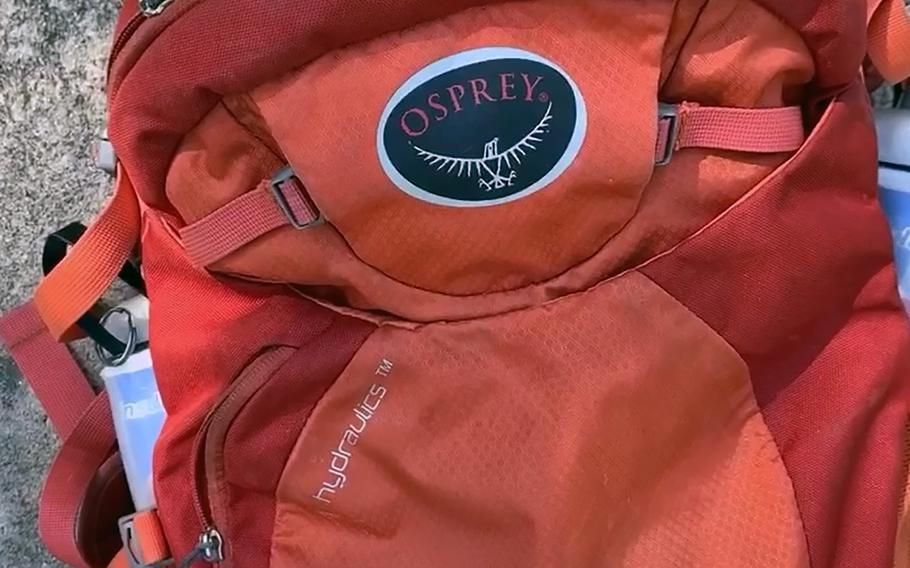
The author hikes in Boulder, Colo. (Rachel Walker/For The Washington Post)
Take a hike. It sounds like the easiest thing to do: Head out and put one foot in front of the other. But if you're not used to being outside in nature, or if walking is difficult for you or if you require a wheelchair or walker, then the very idea of hiking can be intimidating. Resist that reaction. When the opportunity to go on a hike presents itself, take it, advised D.C.-based Florence Williams, author of "The Nature Fix: Why Nature Makes Us Happier, Healthier, and More Creative."
"When we experience beauty and awe, science suggests that it helps us feel more connected to the world around us and to each other," Williams said. "And really, we have evolved to walk. Our bodies and brains feel very comfortable doing it."
You won't be alone; since the pandemic began, people have flocked to the outdoors, where there's plenty of airflow and they can practice social distancing and get exercise. As a result, many state and national parks, as well as local trailheads, have implemented reservation systems or supplied shuttles to minimize parking headaches.
Given the number of people in the outdoors, a summer hike might seem daunting for beginners. But getting started with hiking is relatively easy, said Amy David, a hiking and backpacking guide for Sawtooth Mountain Guides in Stanley, Idaho. Novice hikers may think they need expensive gear or ambitious destinations when, in fact, the only requirement is a desire to get outside. This can be easier in the American West, where state and federal public lands abound, but it is also possible in most parts of the country, she said.

Sawtooth Mountain guide Amy David at Idaho’s Thompson Peak. (Charlotte Ross/For The Washington Post)
"At its simplest, hiking is a way to enjoy the outdoors, fresh air and nature," David said. "You can go to an urban park, but I lean toward backcountry."
Non-hikers might be wary because of pervasive myths that can act as obstacles to getting people onto trails. For one, many people assume they need expensive, fancy gear to go on a hike.
"There are certain types of gear you should have to make your experience safe and enjoyable," David said, "but it doesn't have to cost a fortune."
Hikers should have shoes or boots that fit well to prevent blisters; thin wool socks; a water bottle; wool or synthetic clothes that wick sweat and dry quickly; and, if the weather forecast looks volatile, proper layers to keep you warm and dry. Trekking poles help distribute your weight and make descending hills easier by taking pressure off your leg muscles and joints. Many trekking poles are collapsible, like tent poles, which makes them easy to travel with. For longer day hikes and overnight trips that include sleeping in a tent, the gear list grows. But for a newcomer to the trails heading out for a short or half-day hike, there's no need to purchase a lot of fancy new supplies.
David said some people are also intimidated because they think they must be in peak physical shape and climb a mountain for their hike "to count." Wrong. "A gentle stroll can be a hike," David said. "Hiking is open to most everybody, no matter their experience or fitness level. So long as you enjoy moving your body at a pace that works for you, you're a hiker. And you will continue to progress as you gain more experience and fitness."
Instead of looking for the most beautiful or rigorous trail, David suggested simply finding a pleasant trail and exploring. This is relatively easy with the proliferation of trail-finder apps. David recommended Avenza Maps, OnX and Gaia GPS, adding that the best app is the one you're comfortable using. Most apps rank hikes by difficulty and provide salient information such as round-trip mileage, elevation gain and loss, and more. Printed maps and guidebooks also work, and most outdoor sporting stores have local trail maps. Pop into one on vacation, and you're almost guaranteed to get friendly, local insight that will help you pick the best trail for your objective.

Having a proper map or navigation app and charged electronic device is important for hikes of all lengths and difficulties. (Rachel Walker/For The Washington Post)
There are few things that can ruin a hike as completely as poor-fitting shoes or boots. Blisters can take weeks and sometimes months to heal, and tender feet will restrict movement or even dissuade you from hiking for the rest of the season, said Eric Henderson, a longtime outdoor educator and guide based in Denver.
"I would never advise buying boots online without trying them on first," he said. "The right footwear is essential for an enjoyable hike, and it's worth the time and expense to go to a specialty store to get expert advice."
People's feet are not uniform. Even if you know your size, you may have bunions, arch issues or other complications, Henderson said. That means that fit is paramount, and you won't know whether shoes or boots are a good fit without first trying them on.
When shopping, don't just lace up and shuffle around the shop. Step onto benches, hop around, and go up and down stairs if you can. Henderson said he prefers mid-height boots that provide more ankle support than a hiking shoe but are less burly than a heavy hiking boot.
If all of that sounds intimidating to a first-timer, go ahead and hit the trail in your running shoes, provided they fit well and are broken in so that you don't get a blister, David said. But if your interest in hiking piques, invest in durable, well-made hiking shoes or boots.
There's a popular refrain among hikers: Leave no trace. This is an ethos that comes down to respect, David said. Literally, it means pack out what you pack in, including trash, extra food, orange peels or apple cores (or any other biodegradable refuse that should not be thrown into the bushes). If you hike with a dog, bag its poop and carry it out. And if you have to poop, David offered the following instructions: "Dig a hole, so bring a small trowel, which you can get at an outdoor store, and carry out used toilet paper, so bring a sealable plastic bag for that."
Leave no trace also means respecting others on the trail. Give people space when passing, and don't blare music on portable speakers or through your phone. "Go ahead and listen with earphones, but it's rude to subject others to your music or podcasts," she said.
Equally important is to make sure you bring enough food to stay fueled and water to stay hydrated. David suggested bringing more food than you think you will need (and a comfortable pack for carrying it) and a water filtration system if you plan to replenish your water from a river or creek. "Freshwater does not mean clean water," she said. "Even if it's clear, it can have giardia."

A well-fitting pack is important for carrying your supplies. (Rachel Walker/For The Washington Post)
Hiking need not be relegated to able-bodied people. TrailLink by Rails-to-Trails Conservancy is an online resource (traillink.com) for finding wheelchair-accessible trails around the country. The descriptive trail guides have photos and reviews. Some public land agencies are also adding Braille to trail signs.
Accessibility also extends to groups that have not been traditionally present or active in the outdoors. In recent years, hiking groups for LGBTQ individuals, self-identified fat people, minorities and women have proliferated. The group Diversify Outdoors (diversifyoutdoors.com) has a page devoted to connecting people around the country.
All of which is to say that the outdoors exist for everyone, and exploring nature by foot can be a wonderful way to spend some of your vacation. Not only can hiking allow you to slow down and stimulate your senses, but it can also help you adapt to a new place, Williams said.
"Being outside in the daylight is good for resetting circadian rhythms if you're traveling across time zones," she said. "It's also great for working off the inertia of sitting for long periods in a car or on an airplane."